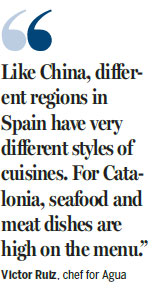Full of spanish heart
A new chef arrives, and something new is in the air
"If you cook with the heart, people feel it," I told Victor Ruiz after tasting his dishes at Agua, the long-established Spanish restaurant in Beijing.
But for Ruiz my suggested recipe for success lacked at least a couple of ingredients, and he replied: "To be a good chef you need hands, a brain and passion."
In Beijing passion is the last of these things that he says is missing in young Chinese chefs. There needs to be more to a chef's vocation than a way of making ends meet, he says.
Ruiz from Catalonia, northeastern Spain, is Agua's newly appointed head chef, succeeding Jordi Valles, who left after working there for eight years, since the restaurant's very first days. So going to Agua recently, we had a mission: to see what bright new ideas the new chef has brought to the restaurant. Eventually we needed no convincing that something new is indeed the air - and it was the taste that did the talking.
Agua, originally opened in 2008 at Ch'ienmen 23 near Tiananmen Square, moved to its current location in 2010 at Nali Patio in Sanlitun, a mecca for lovers of all things Spanish. It is one of more than 20 dining outlets that Aqua Restaurant Group has in Hong Kong, Beijing and London.
The company's founder, David Yeo, a former lawyer and designer, took his inspiration from the warm browns and textures of natural Spanish woods to create a chic interior for Agua. He has also introduced exotic Moorish touches throughout, with colored glass and brass lanterns sourced from the Suks of Morocco and windows and doors in the traditional Moorish shape.
We ordered a number of tapas that included fired homemade chorizo, tortilla, spicy potatoes and cold tomato soup salmorejo, but the best of the starters was the squid noodles with ink and hollandaise sauce (160 yuan, $24).
Why noodles as a starter? The dish plays an amazingly deceitful trick: the squid meat is thinly and dexterously cut into the shape of hand-pulled noodles.
The ink sauce is thick but not heavy; after stirring, the squid noodles look as though they are decked in a dark coat. With its distinct sea taste, but one that is not fishy at all, it is delicious. It imparts an incredible feeling in the mouth because of the springy squid meat and the creamy texture of the ink sauce. This is briny and mildly sour with a special Spanish sauce in it called jerez (sherry vinegar).
The ink and hollandaise sauce also has a slightly sweet twist because of the onions in it, caramelized after six hours of cooking on very low heat, Ruiz says.
The marriage of caramelized onions and squid meat also appears in another of Ruiz's signature dishes, candied and grilled pork belly on top of a base paste of onion and squid, and a side sauce of apricot compote (128 yuan).
In this dish, caramelized onions give the paste a subtle sweetness and wonderfully offset the chewy texture of the squid meat.
Iberian pork and Atlantic squid are quintessentially Spanish, and a gourmet complex of the two apparently goes back to when fishermen used squid in bartering with butchers for pork.
"Like China, different regions in Spain have very different styles of cuisines," Ruiz says. "For Catalonia, seafood and meat dishes are high on the menu."
At Agua the streaky Iberian pork is braised for 10 hours on extremely low heat and then slightly sauteed. The fat meat then seems to dry out, leaving a crisp outer layer.
Apricot compote as a side sauce works very well to balance any oily feel of the pork and onions.
As main dishes we chose the traditional seafood paella that is more familiar to Chinese.
It comes juicy, moist and creamy; in contrast to other versions of paella I have tasted in Beijing that are dry and crisp.
The key ingredient to great paella is the rice. The rice we had was bomba, a short-grain variety Spaniards like in their paella.
Bomba rice tends to be non-sticky and can absorb water well while retaining its shape and not becoming mushy. Ruiz says that in his version he brings a Chinese influence to bear, making the rice softer to suit Chinese palates instead of the crunchy and seemingly half-cooked texture that Spanish people enjoy.
I had thought saffron was a must in paella, but Ruiz says this is not so, and he does not use it.
"Paella comes from Valencia. People in that region tend to put it in paella, but various kinds of paellas have evolved throughout the country, and in Barcelona not that many people put saffron in paellas.
"Another thing is that in China seafood paella is so well known, but in Spain we eat a lot of paellas that do not have seafood in them."
Another thing not to miss in Agua is the ham. It is a 50-month cured Iberico variety from Monsalud, La Dehesa de Extremadura, which was named best Iberico ham in the world in 2011, according to the menu.
Tomato bread, with no garlic on it, is served with the ham, so you will not lose the flavor of the meat.
In Spain, good hams are expensive, Ruiz says.
"For a good ham the pig must grow to about 200 kilos, eating only corn, and must be about 2 years old."
After having been in China for only a few months, Ruiz has realized that Chinese are very fond of Spanish cuisine, and hams, paella, tapas top the list.
One of the special tastes of Spanish cuisine is sofrito, he says.
"It's something you cook really slowly with tomatoes and garlic. We use it in about 80 percent of our dishes."
Ruiz says China and Spain have a common gourmet culture.
"Both Chinese and Spanish people love food and love eating. We also both see eating as a social event for sharing and conversation."
Ruiz got an early start in a professional kitchen when he was 14, in a restaurant his family used to have in Barcelona. When he saw the chef working in there he thought, "I want to be like him", he says.
When he was 19 he won the best young chef prize in a culinary competition in Catalonia, and got an internship in El Bulli, the world-renowned restaurant with three Michelin stars at the time.
Since then he has worked in many other places around the world, including Dublin, London and Paris.
dongfangyu@chinadaily.com.cn
|
Clockwise from top: Agua's newly appointed head chef Victor Ruiz; rigattonis stuffed with prawns bolognese; tuna and wakame salad with strawberries; Spanish cold tomato soup Salmorejo; squid noodles with ink and hollandaise sauce; candied and grilled pork belly on top of onion and squid paste. Photos By Wang Zhuangfei / China Daily |


(China Daily USA 07/25/2016 page8)























